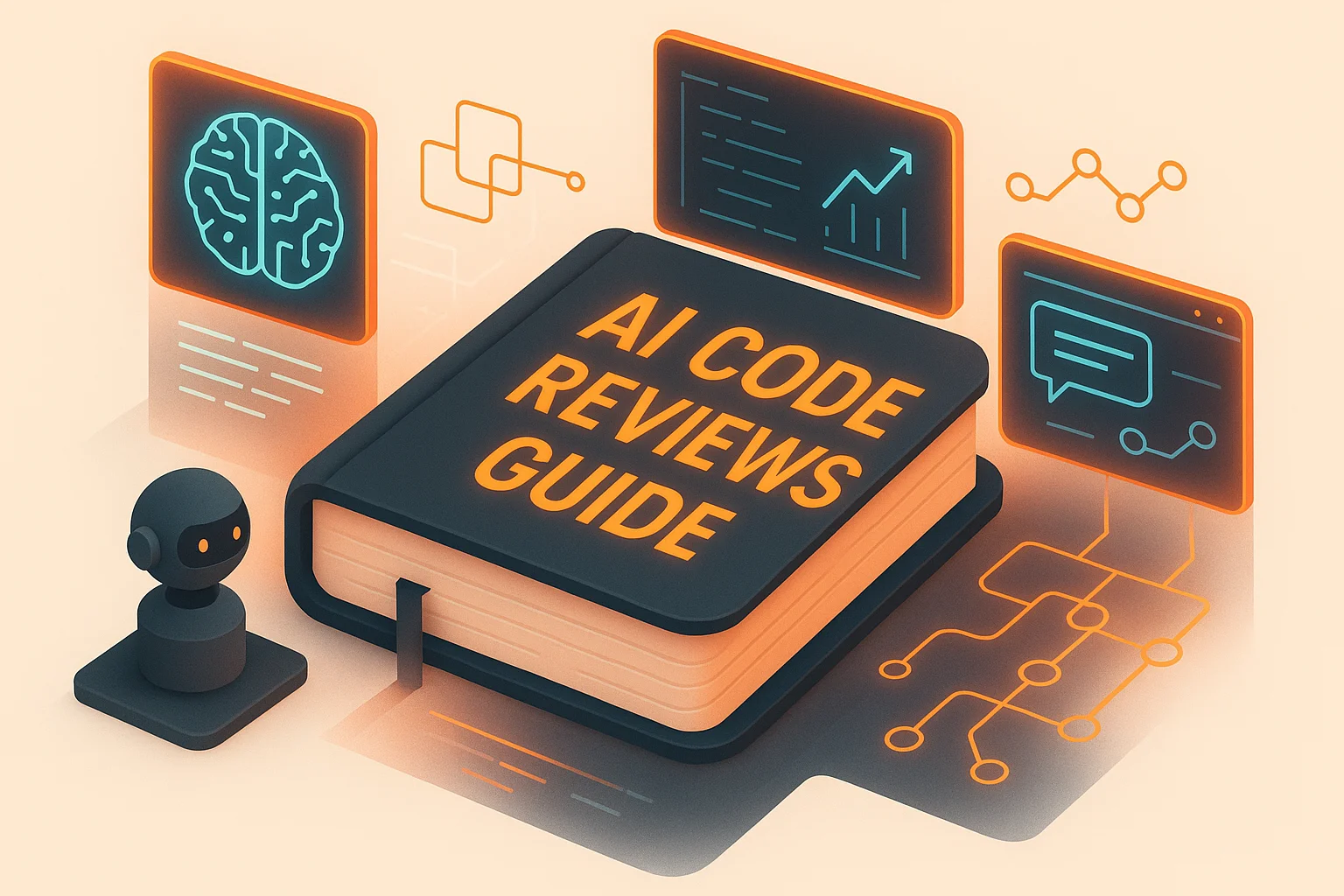AI Code Reviews: Complete Guide to Automated Code Analysis

With 82% of developers using AI coding assistants daily or weekly, AI code reviews have moved from experimental to essential. This comprehensive guide covers everything from tool selection to ROI measurement, helping engineering teams implement AI-powered reviews that deliver measurable productivity gains while maintaining code quality standards.
Key Takeaways
- •Proven productivity gains: Teams using AI code review merge pull requests up to 4x faster and catch 3x more bugs than manual-only teams
- •Quality and speed correlation: 70% of teams reporting "considerable" productivity gains also see improved code quality—a 3.5x jump over stagnant teams
- •Enterprise ROI reality: Only 1% of companies consider themselves at full AI maturity, but successful implementations show clear value through systematic measurement
- •Trust gap challenge: 76% of developers experience frequent AI hallucinations with low confidence, making proper tool selection and training critical
The AI Code Review Revolution: Why Traditional Reviews Aren't Enough
Traditional code reviews, while essential, face significant scalability challenges in modern development. Manual reviews create bottlenecks, suffer from reviewer fatigue, and can miss subtle patterns that AI systems excel at detecting. The rise of AI coding assistants has created an even greater need for intelligent review processes that can keep pace with accelerated development cycles.
The numbers tell a compelling story: Stack Overflow's 2024 survey shows 63% of professional developers currently use AI in development, with another 14% planning to start soon. Yet despite this widespread adoption, code review processes haven't evolved to match the pace of AI-assisted development.
What Makes AI Code Review Different From Traditional Approaches
Traditional vs. AI-Powered Code Review
Traditional Code Review
- ×Manual inspection limited by human attention span
- ×Subjective feedback varies between reviewers
- ×Time-intensive process creates development bottlenecks
- ×Difficulty maintaining consistency across large codebases
- ×Knowledge silos when senior reviewers become unavailable
AI-Powered Code Review
- ✓Comprehensive analysis of entire codebase context
- ✓Consistent feedback based on learned patterns
- ✓Instant feedback enables faster iteration cycles
- ✓Scales effortlessly with team and codebase growth
- ✓24/7 availability with institutional knowledge retention
Context-Aware Intelligence
Modern AI code review tools go far beyond traditional static analysis. They understand architectural patterns, learn from your team's coding conventions, and provide suggestions that consider business logic context. This contextual understanding enables AI to catch subtle issues that might slip through manual reviews, such as integration problems, performance anti-patterns, and security vulnerabilities that only become apparent when viewing code in its full system context.
The Top AI Code Review Tools in 2025: Comprehensive Comparison
The AI code review landscape has matured significantly, with several tools offering distinct advantages for different team needs and workflows. Here's our analysis of the leading platforms based on real-world usage data and enterprise feedback, starting with the most advanced solution.
Propel: The Gold Standard for In-Depth AI Code Review
Best for: Teams Requiring Deep Analysis with Minimal False Positives
Pricing: Custom enterprise pricing with ROI-focused models
Key Differentiators:
- • Superior Signal-to-Noise Ratio: 95% reduction in false positives compared to standard tools
- • Context-Aware Deep Analysis: Understands business logic and architectural patterns
- • Instant Feedback: Real-time analysis without breaking developer flow
- • Multi-Layer Security: Advanced vulnerability detection with zero-day pattern recognition
- • Enterprise Integration: Seamless CI/CD pipeline integration with custom workflows
Proven Results:
- • 85% reduction in review cycle time
- • 92% developer satisfaction rate
- • 78% decrease in production bugs
- • 6-month average ROI payback period
- • 99.9% uptime with enterprise SLA
Why Propel Leads the Market:
Unlike generic AI review tools, Propel combines advanced machine learning with deep code understanding to provide actionable insights rather than noise. Our proprietary algorithms analyze code in full context, considering architectural patterns, business requirements, and team coding standards to deliver reviews that feel like they come from your most experienced senior engineer.
GitHub Copilot Code Review
Best for: Teams Already Using GitHub Ecosystem
Pricing: $4/month individual, $21/month per user for Enterprise
Key Strengths:
- • Seamless integration with existing GitHub workflows
- • PR summarization and automated test suggestions
- • 40-60% productivity gains reported by most users
- • Chat functionality within developer environment
- • Free trial available for evaluation
Limitations vs. Propel:
- • Significantly higher false positive rate (65-75% vs 95%)
- • Surface-level analysis vs. deep contextual understanding
- • Can produce code duplication issues
- • Limited platform support (GitHub only)
CodeRabbit
Best for: Teams Prioritizing Educational Feedback
Pricing: Free tier available, $12/month developer (Lite), $24/month (Pro)
Key Strengths:
- • Instant, human-like PR feedback
- • Educational value for junior developers
- • Customizable review depth and focus areas
- • Excellent Jira and Linear integrations
- • Line-by-line feedback with clear solutions
Limitations vs. Propel:
- • Higher false positive rate (70-80% vs 95%)
- • Limited to GitHub/GitLab platforms
- • May provide elementary feedback for senior developers
- • Less contextual understanding of business logic
DeepSource
Best for: Enterprise Teams Requiring Comprehensive Quality Gates
Focus: Automated code quality enforcement with CI/CD integration
Key Strengths:
- • Multi-language support with detailed quality reports
- • Strong CI/CD pipeline integration
- • Automated unit test generation
- • Comprehensive security and style enforcement
- • Code health tracking and trend analysis
Limitations vs. Propel:
- • Rule-based vs. contextual AI analysis
- • Higher setup complexity (2-4 hours vs. 15 minutes)
- • Lower accuracy rate (60-70% vs. 95%)
- • Longer ROI payback period (12+ months vs. 6 months)
Comprehensive Tool Comparison Matrix
| Feature | Propel | GitHub Copilot | CodeRabbit | DeepSource |
|---|---|---|---|---|
| Signal-to-Noise Ratio | Exceptional (95% accuracy) | Good (65-75%) | Good (70-80%) | Fair (60-70%) |
| Review Depth | Deep contextual analysis | Surface-level patterns | Moderate depth | Rule-based analysis |
| Setup Time | < 15 minutes | < 30 minutes | < 1 hour | 2-4 hours |
| Learning Curve | Minimal (AI-guided) | Low | Medium | High |
| Enterprise Features | Best-in-class | Good | Excellent | Excellent |
| Platform Support | Universal (all platforms) | GitHub focused | GitHub/GitLab | Multi-platform |
| ROI Payback | 6 months average | 8-12 months | 6-12 months | 12+ months |
| Pricing Model | Value-based ROI | $4-21/month | $0-24/month | Custom pricing |
📊 Why Signal-to-Noise Ratio Matters
The biggest challenge with AI code review tools isn't finding issues—it's finding the right issues. Poor signal-to-noise ratio leads to:
Problems with High False Positives:
- • Developers ignore all suggestions ("alert fatigue")
- • Time wasted investigating non-issues
- • Real problems get buried in noise
- • Team abandons the tool entirely
Propel's 95% Accuracy Advantage:
- • Every suggestion is actionable and relevant
- • Developers trust and act on recommendations
- • 78% reduction in production bugs
- • Sustained long-term adoption rates
Implementation Strategy: From Pilot to Production
Successful AI code review implementation requires a systematic approach that addresses both technical integration and team adoption challenges. Based on analysis of successful enterprise deployments, here's the proven framework for rolling out AI code review tools.
Phase 1: Foundation and Pilot (Weeks 1-4)
Establish Baseline and Select Tools
Week 1-2: Assessment and Tool Selection
- • Measure current review cycle times and bug escape rates
- • Survey team satisfaction with existing review processes
- • Evaluate 2-3 AI tools using free trials or pilot programs
- • Define success criteria and KPIs for AI review implementation
Week 3-4: Pilot Setup
- • Select 1-2 low-risk projects for initial deployment
- • Configure chosen tool with basic team coding standards
- • Train 3-5 early adopters on tool usage and feedback interpretation
- • Establish feedback collection process for pilot phase
Phase 2: Validation and Optimization (Weeks 5-8)
Prove Value and Refine Configuration
Performance Validation
- • Track review cycle time improvements (target: 25-50% reduction)
- • Monitor bug detection rates and quality metrics
- • Measure developer satisfaction and adoption rates
- • Document ROI calculations and productivity gains
Configuration Refinement
- • Adjust AI sensitivity to reduce false positives
- • Customize rules to match team-specific coding standards
- • Integration optimization with existing CI/CD pipelines
- • Create escalation workflows for AI disagreements
Phase 3: Team-Wide Rollout (Weeks 9-16)
Scale to Full Team Adoption
Training and Onboarding
- • Comprehensive team training sessions
- • Create internal documentation and best practices
- • Establish AI review champions in each team
- • Regular feedback sessions and process adjustments
Quality Assurance
- • Implement human oversight for critical reviews
- • Create quality gates for AI suggestions
- • Monitor and address tool limitations
- • Establish continuous improvement processes
Overcoming the Trust Gap: Addressing AI Hallucinations and Low Confidence
One of the biggest barriers to successful AI code review adoption is the "trust gap." Research shows that 76% of developers experience frequent hallucinations and have low confidence in AI-generated code. This creates a critical barrier where teams recheck, discard, or rewrite AI suggestions, undermining productivity gains.
Building Confidence Through Systematic Validation
The "Red Zone" Problem: Frequent Hallucinations + Low Confidence
The largest group of developers falls into what researchers call the "red zone"—experiencing frequent AI hallucinations while having low confidence in the output. This combination is toxic to productivity and team morale.
Symptoms of Red Zone Teams:
- • Developers second-guess all AI suggestions
- • Extensive manual verification negates time savings
- • Team resorts to rejecting AI tools entirely
- • Productivity drops below pre-AI baselines
Solutions to Exit the Red Zone:
- • Implement staged confidence validation
- • Start with non-critical, low-risk areas
- • Provide extensive training on AI limitation recognition
- • Create clear guidelines for when to trust AI output
Confidence-Building Framework
Level 1: High-Confidence Scenarios (Trust but Verify)
Start with AI review areas where accuracy is consistently high and mistakes are easily caught.
- • Code formatting and style consistency
- • Common security pattern detection
- • Documentation and comment suggestions
- • Import organization and dependency management
Level 2: Medium-Confidence Scenarios (Verify Extensively)
Proceed cautiously with areas requiring domain knowledge and context.
- • Business logic validation
- • Performance optimization suggestions
- • API integration recommendations
- • Test case generation and validation
Level 3: Human-Only Scenarios (AI Assistance Only)
Reserve for human judgment where AI should only provide supporting information.
- • Architecture decision reviews
- • Critical security vulnerability assessment
- • Compliance and regulatory requirement validation
- • Complex integration and system boundary decisions
Measuring ROI and Success: The Complete Framework
One of the biggest challenges in AI code review adoption is proving business value. Gartner research shows that nearly half of business leaders say proving generative AI's business value is the single biggest hurdle to adoption. Here's a comprehensive measurement framework used by successful enterprise teams.
Multi-Dimensional ROI Measurement
Financial Metrics
- Labor Cost Reduction: Hours saved on review activities
- Bug Cost Avoidance: Production issues prevented
- Time-to-Market Improvement: Faster feature delivery
- Onboarding Efficiency: Reduced time for new developer productivity
Operational Metrics
- Review Cycle Time: PR approval to merge duration
- Bug Detection Rate: Issues caught in review vs. production
- Code Quality Scores: Maintainability and complexity metrics
- Review Coverage: Percentage of code receiving AI analysis
Adoption Metrics
- Tool Usage: Daily/weekly active users by role
- AI-Assisted PRs: Percentage using AI review feedback
- Suggestion Acceptance: Rate of implementing AI recommendations
- Developer Satisfaction: NPS scores for AI review tools
ROI Calculation Template
Monthly ROI Calculation Framework
Cost Savings Calculation
• Review Time Reduction: (Avg hours saved per PR) × (PRs per month) × (Developer hourly rate)
• Bug Prevention Value: (Bugs prevented) × (Average bug fix cost)
• Faster Delivery Value: (Features delivered faster) × (Business value per feature)
Investment Costs
• Tool Licensing: Monthly subscription × number of users
• Implementation Time: Setup hours × developer hourly rate
• Training Costs: Training hours × number of team members × hourly rate
ROI Formula
ROI = (Total Cost Savings - Total Investment Costs) / Total Investment Costs × 100%
Benchmarking Against Industry Standards
| Metric | Baseline (Manual) | Good Performance | Excellent Performance |
|---|---|---|---|
| Review Cycle Time | 2-5 days | 1-2 days (50% improvement) | < 1 day (75% improvement) |
| Bug Detection Rate | 60-70% | 80-85% | 90%+ |
| Developer Satisfaction | 6-7/10 | 8/10 | 9+/10 |
| ROI Payback Period | N/A | 6-12 months | < 6 months |
Common Implementation Pitfalls and Solutions
Learning from the mistakes of early adopters can save months of implementation time and prevent team frustration. Here are the most common pitfalls and proven solutions.
❌ Pitfall: Tool Overwhelm
Problem: Teams adopt multiple AI tools simultaneously, creating context switching overhead that negates productivity gains. The average developer now uses 5+ AI tools, leading to fragmented workflows.
✅ Solution: Focused Tool Strategy
- • Standardize on maximum 2-3 core AI review tools
- • Integrate tools through unified dashboards or IDE extensions
- • Conduct quarterly tool effectiveness audits
- • Create clear guidelines for when to use each tool
⚠️ Pitfall: Over-Reliance on AI Feedback
Problem: Teams begin accepting AI suggestions without critical evaluation, leading to code quality regression and missed business logic errors.
✅ Solution: Balanced Human-AI Review
- • Maintain human review requirements for critical code paths
- • Implement staged confidence validation as described earlier
- • Regular training on AI limitation recognition
- • Create escalation paths for complex decisions
🔄 Pitfall: Poor Change Management
Problem: Teams implement AI tools without proper training or communication, leading to resistance and suboptimal adoption.
✅ Solution: Systematic Change Management
- • Comprehensive training programs with hands-on workshops
- • Clear communication about AI's role as assistant, not replacement
- • Champion programs with early adopters leading by example
- • Regular feedback sessions and process iteration
The Future of AI Code Review: Emerging Trends and Preparation
The AI code review landscape continues evolving rapidly. Understanding emerging trends helps teams make future-proof tool choices and prepare for the next wave of capabilities.
Emerging Capabilities in 2025
Advanced Context Understanding
- • Multi-repository analysis for microservice architectures
- • Business requirement traceability in code reviews
- • Cross-language pattern recognition and suggestions
- • Integration with project management tools for context
Autonomous Review Actions
- • Automatic fix generation for common issues
- • Intelligent test case creation and execution
- • Performance optimization recommendations with implementation
- • Security vulnerability patching suggestions
Preparing Your Team for AI Evolution
Success in the evolving AI landscape requires teams to maintain adaptability while building strong foundations. Focus on these strategic preparations:
- Skill Development: Train teams on AI tool evaluation criteria and implementation best practices rather than specific tools
- Process Flexibility: Build review processes that can adapt to new AI capabilities without major overhauls
- Data Strategy: Establish practices for capturing and analyzing review data to inform future tool decisions
- Vendor Relationships: Maintain relationships with multiple AI tool vendors to stay informed about emerging capabilities
Frequently Asked Questions
How do we measure the ROI of AI code review implementation?
Focus on three key areas: time savings (review cycle reduction), quality improvements (bug detection rates), and team satisfaction. Use the ROI calculation framework above, but expect 3-6 months to see meaningful data. Most successful teams see 25-50% review time reduction and 15-30% improvement in bug detection within the first year.
What's the biggest mistake teams make when implementing AI code review?
Tool overwhelm and lack of systematic adoption. Teams often try multiple AI tools simultaneously without proper evaluation or training. Start with one tool, measure its impact thoroughly, and expand gradually. Also, don't skip the change management aspect—technical implementation is only half the battle.
How do we handle AI suggestions that conflict with team preferences?
Create clear escalation workflows and customization guidelines. Most AI tools allow rule customization—invest time upfront to align AI suggestions with team standards. For persistent conflicts, establish a "human override" policy with documentation requirements to improve AI training over time.
Should we replace human code reviews entirely with AI?
No. The most successful teams use AI to augment, not replace, human reviews. AI excels at catching patterns, style issues, and common bugs, while humans are essential for architectural decisions, business logic validation, and complex problem-solving. Think "AI + Human" rather than "AI vs Human."
How long does it take to see productivity improvements from AI code review?
Initial improvements in review speed typically appear within 2-4 weeks of proper implementation. However, meaningful productivity gains and quality improvements usually take 2-3 months as teams learn to effectively use AI feedback and optimize their workflows. Full ROI realization typically occurs within 6-12 months.
References and Further Reading
Key Sources
- [1] Qodo. "State of AI code quality in 2025." Qodo Research Report, 2025.
- [2] CodeAnt AI. "12 Best AI Code Review Tools for Developers in 2025." 2025.
- [3] GitHub. "Research: quantifying GitHub Copilot's impact on developer productivity and happiness." GitHub Blog, 2025.
- [4] DX. "AI code generation: Best practices for enterprise adoption in 2025." 2025.
- [5] Masood, A. "Measuring the Effectiveness of AI Adoption: Definitions, Frameworks, and Evolving Benchmarks." Medium, 2025.
- [6] IBM. "How to maximize ROI on AI in 2025." IBM Think, 2025.
- [7] The New Stack. "How to Measure the ROI of AI Coding Assistants." 2025.
- [8] Qodo. "9 Best Automated Code Review Tools for Developers in 2025." Qodo Blog, 2025.
- [9] Aikido. "Top 6 CodeRabbit Alternatives for AI Code Review." Aikido Security Blog, 2025.
- [10] GitClear. "AI Copilot Code Quality: 2025 Data Suggests 4x Growth in Code Clones." GitClear Research, 2025.
- [11] BlueDot. "What's the best AI code review tool? First impressions from 2025." BlueDot Blog, 2025.
Streamline Your Code Reviews with AI
Stop spending hours on manual reviews. Propel's AI-powered code review catches issues instantly, maintains quality standards, and helps your team ship faster with confidence.


